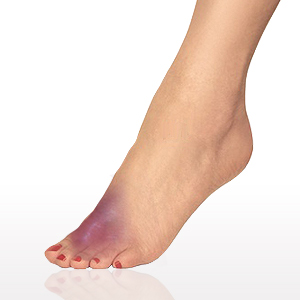Gout Symptoms

Fingers, wrist, elbow, knee, ankle, thumbs or foot, gout can affect any of part of the body. But, in majority of cases, the most commonly affected joint is the big toe. Many may wonder why? The reason attributed is that the big toe is the farthest part of the body; the blood is cooler around this joint and has a high tendency for deposit of uric acid crystals. Numerous studies indicate that there is a high possibility for gout to affect the cooler extremities most often.
Know the connection between Gout and high uric acid in the blood. Understand gout symptoms, the causes and diagnosis procedures. Check out why following gout diet help find relief from gout pain and keep gout attacks at bay.
Gout and high uric acid
A higher-than normal level of uric acid in the blood is the contributing factor for gout. Uric acid (urate) is a substance that gets created when the body breaks down substances called purines. Purines are nitrogen-containing compounds which are made by the body inside the cells or are found in foods and drinks that are consumed.
If the body makes higher than normal uric acid or if the kidneys have a tough time getting rid of uric acid from the body, it leads to accumulation of uric acid. When the level of uric acid builds up in the body, it leads to a condition called hyperuricemia. As such the condition is not serious.
Not all those with hyperuricemia develop gout. But it can be understood as an indication and the chances are high for developing gout. If the elevated levels of uric acid results in painful arthritic attacks due to buildup of uric acid crystals in and around the joints, it is gout. The pain, joint inflammation is due to white blood cells engulfing the uric acid crystals.
Gout symptoms
The first fiery gout attack will usually be in the night sans any warning. It could be the big toe or around any joint and may last for five to ten days. It can be a combination of sudden burning pain, stiffness and swelling. The next attack may not happen for months or even years.
The discomfort and pain is likely to be most severe within the first 12 to 24 hours. Even after the pain subsides, a lingering discomfort may last for few more days. Typical gout symptoms include:
- Flu like symptoms - fever, chills and malaise.
- Sudden intense pain in one or more joints or the big toe.
- Swollen red skin, warm to touch.
- Skin around the joint turning red or purple in color.
- Continued discomfort.
Gout causes
Though the relationship between gout and uric acid crystal formation is well understood, the exact cause for gout is still unknown. There are many circumstances that can lead to increase in uric acid formation.
- Due to under performing kidneys, there is an increase in the production of uric acid in the body
- Due to kidney disease, the body may not be able to clear the uric acid out of the system.
- Increase in the consumption of certain foods and/or increase in alcohol consumption increases the chance of developing gout.
- Intake of certain medications like aspirin or niacin, diuretics, medicines that cause rapid cell death, cyclosporine or other
medicines that suppress the immune system can contribute to increase in uric acid levels.
- Endocrine or metabolic conditions can also be a reason.
- Deficiency in vitamin C intake.
- Being overweight and or following a sedentary lifestyle.
- People with certain conditions like obesity, high blood pressure, diabetes mellitus, bone marrow disorders, and lipid disorders are at risk of developing gout.
- Gout has a hereditary aspect too. Those with a family history of gout are likely to develop the disease.
- Age and sex also play a significant role. Men are likely to develop between the ages of 40 and 50 and women are likely to develop symptoms after menopause.
Gout diagnosis
If the symptoms of gout are consistent, it can be understood as the onset of gout. Early, prompt diagnosis will help decide treatment plan. Also, if left untreated, gout may result in increased pain and damage the joints. Those diagnosed with gout are at risk for cardiovascular disease. Hence, it is best to seek an immediate appointment with a health care provider.
The doctor will conduct a physical examination of the musculoskeletal system; with specific focus on commonly affected joints. And may ask questions related to family medical history. At this point, it is essential to disclose prescription and non prescription medications being taken, if any. Intake of medicines can change or affect test results that may be required to diagnose gout.
As gout can easily mimic the symptoms of medical conditions such as pseudogout, psoriatic arthritis, rheumatoid arthritis or an infection, tests such as serum acid test, synovial fluid test and an x-ray will be required to confirm diagnosis of gout and/or rule out other medical conditions.
Close to confirming test date, the doctor will explain how consumption of certain foods that are high in purine may increase levels of uric acid. These include kidneys, liver, sweetbreads, sardines, anchovies, and meat extracts.
Serum uric acid test
This test measures the amount of uric acid in blood. A blood sample from the vein, preferably the vein in the arm is required. It is usually done four to six weeks after a gout attack. The age, gender, health history are given due considerations while examining the results of the test. The results are considered normal if the test result for adult male is 2.5-8 mg/dL (150-480 micromol/L) (3) and for adult female is 1.5-6 mg/dL (90-360 micromol/L (3). This may vary from one laboratory to another.
However, the doctor will explain the results and confirm prevalence of gout depending on the levels of uric acid in the blood. Serum uric acid test is not considered the most definitive way to diagnose gout. Hence, the next test would be to take a sample of fluid from the affected joint and test it for urate crystals.
Synovial fluid analysis
Synovial fluid is the fluid around the joints that allow lubrication of the joints. Synovial fluid analysis includes a group of tests performed to rule out septic arthritis, to understand inflammatory response, infection and to identify monosodium urate or calcium pyrophosphate dehydrate crystals in aspirated synovial joint fluid. With regard to diagnosis of gout, the tests will prove helpful to examine chalky, sodium urate deposits (tophi) around the joints.
In most cases, local anesthesia is administered before collecting sample. The entire procedure is completed in less than a minute. The collected fluid is analyzed for volume, color and clarity and the amount of glucose, uric acid or total protein. Abnormal joint fluid may look cloudy or abnormally thick. But, laboratory test results may vary depending on age, gender, health history, the method used for the test, and many other factors. For uric acid levels rise and fall depending on many complex factors in the body.
X-ray: An x-ray will not help diagnose gout. The primary purpose of taking an x-ray is to rule out other medical conditions which cause the pain and related discomfort and to monitor the effects of inflammation and pain on joints.
Gout diagnosis confirmation
The tests will be followed by a detailed analysis aimed at understanding the pattern of pain and associated symptoms of gout. If majority of patterns prevail, it confirms onset of gout.
- The number of gout attacks and the symptoms of pain, swelling and inflammation.
- If the inflammation has recurred within a day of the onset of symptoms.
- If the symptoms affect one joint or more at a time including the big toe.
- Taking into account the results of the serum acid test - the levels of uric acid in the blood.
- Accounting for detection of swelling during physical examination and through x-rays.
- If there are any bacterial infections.
Gout attacks
When the body responds to the presence of uric acid crystals with a sudden inflammatory reaction, it is termed as gout attack.Most of the time, gout attacks happen at night. The pain, described best as burning pain, can be very intense and so bad that the joints can't even
stand the slightest touch. Walking or standing may become difficult and almost impossible.
Gout attack can occur suddenly for no apparent reason. The attack can happen in the same join again and again. Mild gout attack may last for a day or two and then the symptoms will diminish. Severe attacks may last up to several weeks. Subsequent to an attack, the next one is most likely to occur within 6 months to 2 years. There are also instances where there has never been another gout attack after the first/initial attack.
Gout treatment
Gout cannot be cured but can be treated successfully. Gout attack symptoms are often relieved within 24 hours after treatment has begun. A good gout treatment plan will target the immediate need, address long-term management of gout attacks and prevent development of further complications. Stopping the pain and providing relief from pain and inflammation associated with gout attacks would be the priority, besides containing gout attacks. All the while concentrating on reducing the amount of urate in blood.
Medications: Anti-inflammatory medications and pain relievers are prescribed for gout pain relief. NSAIDs (non-steroidal anti-inflammatory drugs) (Examples: indomethacin and naproxen), Colchicines, Steroids (Example: prednisone) are effective in getting relief from pain, reduce inflammation, reduce and prolong frequency of gout attacks.
Also, doctors recommend a high liquid intake to facilitate increase in daily urine output. Medicines that lower the level of uric acid in the blood will be prescribed (Example: allopurinol or probenecid.). These are recommended for those who have had multiple attacks of gout or kidney stones due to high levels of uric acid. A prescription for lifestyle changes will be provided. It includes:
- Avoid/reduce alcohol intake.
- Increase water intake or fluids.
- Maintain an ideal body weight in relation to gender, age and height.
- Avoid fasting/following a weight reduction plan.
- Doctors also recommend following a healthy dietary plan.
Gout diet
The role of a healthy dietary regimen cannot be overlooked. Need for dietary restrictions are reduced and taken care of with medications. Gout diet plays a vital role in decreasing the severity or frequency of gout attacks. A gout diet is agout friendly diet with
particular reference to avoiding foods that are high in purines, which help control body's production of uric acid.
- Avoid/limit high purine foods such as sweetbreads, anchovies, yeast, sardines, liver, kidneys, brains, red meat, meat extracts, herring, mackerel, scallops, gravy.
- Take in moderate quantities of vegetables like asparagus, cauliflower, spinach, mushrooms, green peas, lentils, dried peas and beans, oatmeal, wheat bran and wheat germ.
- Eat more beans and legumes.
- Drink 2-3 liters of fluids everyday.
- Abstain totally or at least limit alcohol/beer consumption to 1 drink three times a week.
- Limit protein intake. Switch over to low-fat or fat-free dairy products.
- Use less oil for cooking.
- Limit or avoid sugar intake, sugar-sweetened drinks, and sugar in the form of fructose as it can raise the uric acid levels and precipitate gout.
Gout pain relief - 5 easy ways
A combination of regular exercising, avoiding high purine foods, liberal fluid/water intake, a healthy dietary regimen and maintaining an ideal weight indeed are effective in alleviate gout pain.
Top of the Page: Gout Symptoms
Tags:#gout treatment #gout symptoms #gout causes #gout diagnosis #gout diet #gout attacks #gout pain relief
 Healthy Habits for Women
Healthy Habits for Women Obesity indicator - ABSI Calculator
Fighting Diabesity
Depleted Immune System
Gonzalez Regimen for Cancer
Irritable Bowel Syndrome
Inflammatory Bowel Disease
Healthy Eating Habits
Diabetes Prevention Tips
Ankle Edema
Deep Vein Thrombosis
Colon Cleansing
Women and Substance Abuse
Water Retention Causes
Improving Blood Circulation
More on Women Health
 Shortness of Breath
Shortness of Breath Eosinophilic Esophagitis
Feminine Hygiene
Nail Fungus
Antidepressants and Weight Gain
Iron deficiency Anemia
Avian Flu Pandemic
Mood swings and women
Medical Alert Devices
Hypokalemia
Metabolic Syndrome X
Heat Stroke
Altitude Sickness
Body Sculpting
Gout Symptoms
Polymyalgia Rheumatica
Systemic Lupus
Reflex Sympathetic Dystrophy
Carcinoid
Chronic Sciatica
Diet and Kidney Disease
Loss of Appetite
Suppress Appetite
How to Improve your Memory
Short Term Memory Loss
Leg Cramps at Night
Top of the Page: Gout Symptoms
Popularity Index: 102,112

